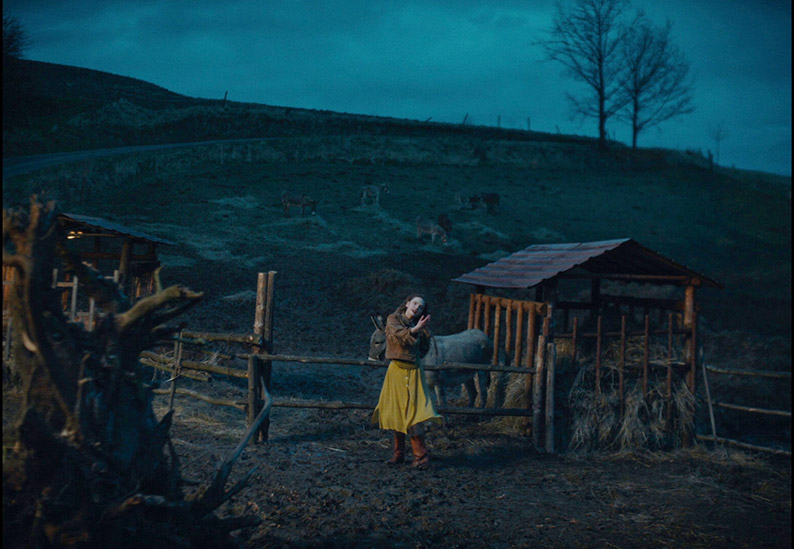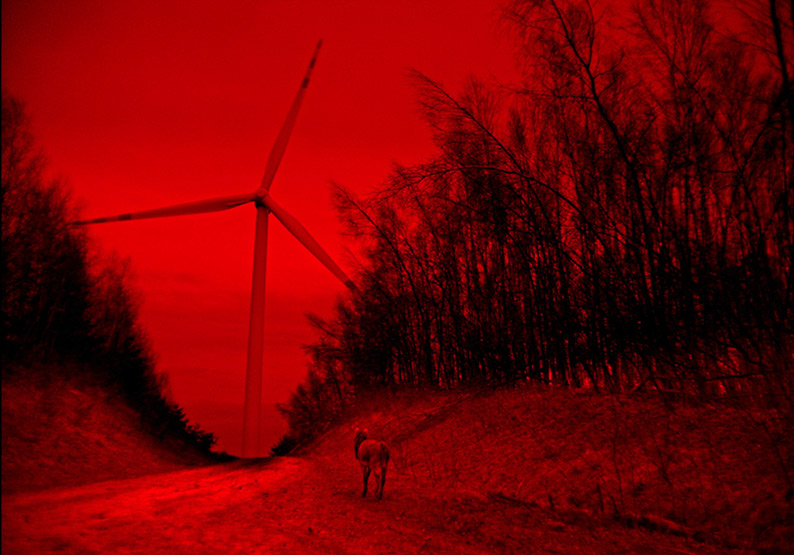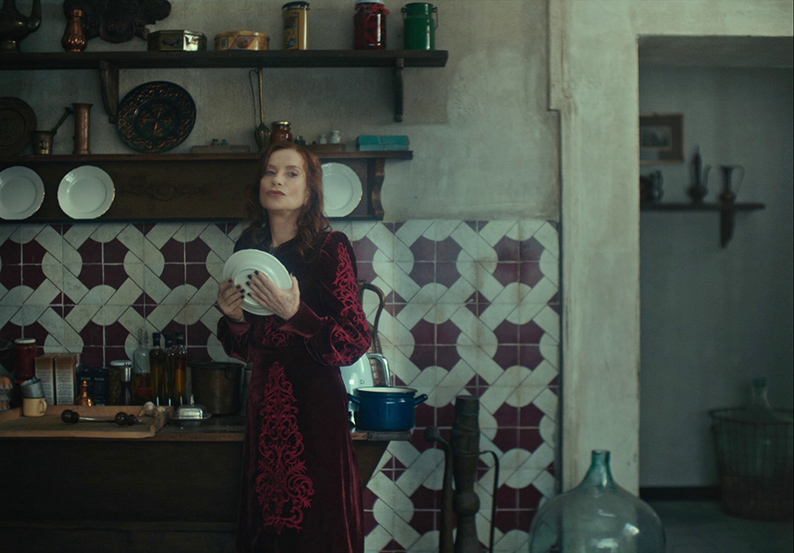|
EO, with its onomatopoeic donkey bray of a title, is a cinematic "answer record" to another film, namely Robert Bresson's Au hasard, Balthazar. Jerzy Skolimowski first saw Bresson's film when it topped Cahiers du Cinéma's 1966 poll of the best films of the year, with his own Walkover coming second. Looking to see what kind of film had beaten his own into second place, Skolimowski went to see the film in a partly cynical frame of mind, and partly in an analytical one, to see what he could learn from it. By the end of the film he was in tears, the first and only film to have that effect on him. Balthazar was one of the few films not aimed at children or families to feature an animal protagonist, and if you eliminate animated films like Fritz the Cat, there are even fewer. But now, with EO, we have another one.
We follow EO from its (I'm using that pronoun as EO's sex is unspecified and both male and female donkeys are used in the film) birth, rendered with a red-suffused screen and flickering lights, through the whole of its life. (Anyone susceptible to lights at strobe frequency should be careful of that opening sequence.) EO begins in a circus, looked after by Kasandra (Sandra Drzymalska). However, EO is liberated by animal rights activitists and placed in a sanctuary, where Kasandra continues to visit, even bringing it a carrot muffin as a birthday present. However, soon EO escapes and goes wandering through the Polish towns and countryside…

EO was played by six different donkeys, though two did most of the work: Tako played the role in most shots, with Hola used for close-ups. The other four were stand-ins: Marietta, Ettore, Rocco and Mela. The human cast are distinctly secondary, mostly appearing briefly, though there are occasional diversions away from EO: one involving a truck driver who pays a price for lechery and another featuring third-billed Isabelle Huppert as "The Countess", speaking French and Italian. Like Skolimowski's 2010 film Essential Killing, but for an obviously different reason, EO depends very little on dialogue, and has long stretches without any. Skolimowski and his cowriter Ewa Piaskowska instead take the films into the realms of abstraction, with human landmarks like a bridge across a dam or wind turbines taking on a surreal cast. At times we may be entering EO's dreams, such as in a night scene in a woodland with green lasers from a hunt penetrating the gloom, or in another strange scene involving a robot quadruped.
Bresson's film has religious overtones common to the rest of his work, but these are absent from Skolimowski's film. We're clearly meant to feel empathy with EO, even without possibly sharing its dreams. On its journey, EO meets several other animals, often confined or shortly to be put down. In one town, EO wanders down the main street only to pause outside a pet shop. At times he is captured and at one point beaten up and left for dead by a gang of football hooligans.
In the absence of dialogue for the most part, the film relies heavily on not just Skolimowski's direction but on Michał Dymek's cinematography, which runs the gamut from an ultra-sharp unfiltered look but also in scenes dominated by red washes. The soundtrack also plays a part, with much use of directional sound and Paweł Mykietyn's music score.

Following his fifth feature film Hands Up! (Ręce do góry), which was banned by the Polish authorities, Skolimowski left his native country. After a long exile, when he worked and lived overseas, and a hiatus from filmmaking anywhere that lasted seventeen years, he returned to Poland. EO is his fourth film of his second Polish period, all produced and/or cowritten by Ewa Piaskowska, who is also his wife. He is, as I write this, eighty-four years old, and clearly creatively still firing on all cylinders.
Paweł Mykietyn won the Soundtrack Award at Cannes in 2022, with the film sharing the Jury Prize with the Italian film The Eight Mountains. It was also Oscar-nominated as Poland's entry for Best International Film.
The BFI's release of EO is a dual-format release with a Blu-ray disc encoded for Region B only and a PAL-format DVD encoded for Region 2. A checkdisc of the former was supplied for review and the timings below refer to this version. EO carries a 15 certificate, while High Rise Donkey is a U.
EO was digitally captured on the Arri Alexa Mini at 4.5K resolution. The Blu-ray transfer is in the decidedly non-standard aspect ratio of 1.43:1. That's the IMAX ratio, IMAX film for that matter (digital IMAX is usually 1.90:1), though I do not know if the film has had any showings in that format, or any showings on any kind of film for that matter. Given that the film has existed in the digital realm from shooting to distribution, you'd expect it to look pristine, and it does, much as I remember it from a DCP cinema showing, with Dymek's various colour palettes coming across strongly.

The soundtrack, with dialogue mainly in Polish with some Italian, French and English, is available in two flavours, DTS-HD MA 5.1 and also LPCM 2.0, which plays in surround. There's little difference between the two tracks, both of which are mixed loud. As I say above, there is a lot of directional sound, and the only real difference is the greater bass enhancement of the LFE track in the 5.1 mix. Two sets of subtitles are available: English translating the non-anglophone dialogue and an English hard-of-hearing track. Both are optional, if you are sufficiently polyglot to be able to do without them.
Interview with Jerzy Skolimowski and Ewa Piaskowska (26:47)
Following a screening of EO at the Lincoln Center, New York, in November 2022 as part of the New York Film Festival, Skolimowski and Piaskowska are briefly interviewed. The interviewer is Madeline Whittle, though she is not identified on screen. Skolimowski spends the best part of twenty minutes answering just one question, where he is asked about his liking for non-linear narrative, if not actual abstraction. Skolimowski answers that he is bored by the three-act formula, with plot points expected to happen at particular time counts. Piaskowska, other than offering to interpret, something not actually needed, doesn't get to say anything until the second and final question, about the tone of the film.
Trailer and teasers
With a Play All option, we are shown the theatrical trailer (1:45) and three teasers, entitled Eyes (0:13), Red Circle (0:14) and Windmill (0:15). The latter are as abstract as their brevity and titles would indicate.
Skolimowski A to Ż (52:14)
Note that diacritic mark over the Z. Michael Brooke covers Skolimowski's life, career and films by means of the alphabet. A is for Andrzej as there are three men of that name of significance in Skolimowski's career, firstly Wajda, who brought him on board on his 1960 film Innocent Sorcerers (Niewinni czarodzieje) because he felt that Skolimowski, then in his early twenties, was much more likely to be in touch with the young characters of the film than the then middle-aged Wajda and cowriter Jerzy Andrzejewski. Skolimowski also played an uncredited role as a boxer, something he had had experience of in real life. The second Andrzej is his mentor the director Andrzej Munk and the third is Andrzej Leszczyc, whom Skolimowski played in three of his early films. Other personal influences include two Js for Jeremy: producer Thomas (who produced The Shout (1978) and executive-produced EO) and actor Irons, who played the lead in Moonlighting (1982). That diacritic is explained by Z being for życie, the Polish for life, as it's Skolimowski's we've had an overview of for the last fifty-two minutes. This item plays over the film as a third audio track, being replaced by the film sound after it ends.

High Rise Donkey (56:19)
Much can be said of the Children's Film Foundation, or as it had become in 1980 when this film was made, the Children's Film and Television Foundation, being the starting point for many a career both in front of and behind the camera. However, it was also a resting place for great names of the past as their careers reached their twilights. Michael Powell is the best-known example, as his and Emeric Pressburger's final fiction film was made for the CFF, The Boy Who Turned Yellow (1972). Here, it's the turn of T.E.B. Clarke, who had won an Oscar for The Lavender Hill Mob and had also written The Titfield Thunderbolt and The Blue Lamp, among others. It's fair to say that he didn't go out in a blaze of glory with High Rise Donkey, his final writing credit. The film follows the usual formula of CFF films, with an ensemble cast of both sexes (here, two sisters and their brother) who look after Barney (played by Prince), the donkey owned by scrap merchant Ben Foxcroft (Wilfrid Brambell) who is hospitalised after an accident. Despite the title, for only part of the film is Barney in the high-rise home of the principals and their mother. Barney is targeted by a gang of thieves and ends the film as effectively an emotional support animal to showjumping horse Bright Star. It's bland stuff and oddly dated even for 1980. I doubt that "groovy" was current kid slang then. There's also a bit of incidental discriminatory language when a turban-clad Indian bus conductor is addressed as "Sabu", which is a film reference even less for the teenagers. None of the three children (Leigh Gotch, Wendy Cook and Linda Frith) went on to adult careers, but there are several familiar faces in the adult cast, including James Ellis, Harry Fowler, Roy Kinnear, Sam Kydd, Alfie Bass, Pat Coombs and, as himself, Keith Chegwin. The film is presented on this disc in a ratio of 1.33:1 (though undoubtedly shown in cinemas wider than that) with mono sound.
The Clown and His Donkey (3:39)
Dating from 1910, The Clown and His Donkey is a charming piece of reverse-silhouette (white on black) animation, British made though the title card of the present copy is in German.
Booklet
The BFI's booklet, available with the first pressing only, runs to twenty-eight pages. The lead essay (with a spoiler warning) is by Ewa Mazierska, who has written a study of Skolimowski's work. It's a thorough overview of EO, covering the inception and making of the film, and its themes of the abuse of animals. (None of the animals on screen were actually mistreated.)
Next up is an interview with Skolimowski and Piaskowska, conducted by David Thompson in London in November 2022, a shorter version of which can be read here https://www.bfi.org.uk/sight-and-sound/interviews/jerzy-skolimowski-donkey-drama-eo. The interview covers the inception and themes of the film, with much emphasis on the cruelty to animals portrayed on screen. The booklet then reprints Christina Newland's review from the February 2023 issue of Sight & Sound, full film credits, and notes on and credits for the extras. Those notes include short essays by Vic Pratt on High Rise Donkey and Lillian Crawford on The Clown and His Donkey.
EO is Jerzy Skolimowski's eighteenth feature film and one of his best, taking his filmmaking into new areas, despite its origins in Bresson's earlier work. It's well served by this dual-format BFI release.
|